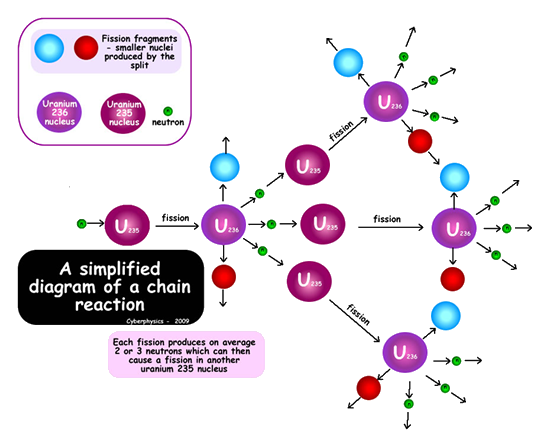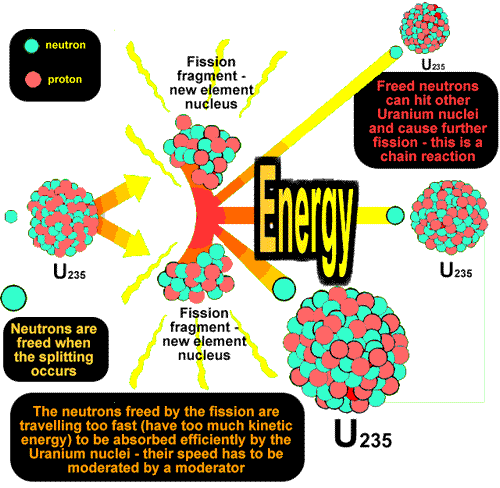Chain reaction
17.36
Diposting oleh Melany Christy
The only problem with the chain reaction is the fact that each stage of the reaction instigates more than twice as many fissions as the next stage (almost three times as many!).This results in the amount of energy produced at each stage more than doubling if the reaction is left unchecked. Each stage occurs in less than a millionth of a second therefore the heat energy produced can be phenomenal.The reaction is said to escalate. If we requirea steady energy output of energy only one neutron from each fission should be allowed to go on to make another fission reaction. The reaction needs to be controlled - see control rods.
The diagram below summarises what happens in a chain reaction. You are often asked to sketch a diagram to show chain reactions in exams - make sure you label them properly.

The atmosphere
04.27
Diposting oleh Melany Christy
The Earth's atmosphere is a layer of gases surrounding the planet Earth that is held in place by the pull of Earth's gravity.
The Earth's atmosphere contains a mixture of gases is commonly known as air:
- 78% nitrogen,
- 21% oxygen,
- 0.93% argon,
- 0.04% carbon dioxide - although this is increasing
- water vapour (average of 1% - but that varies).
- trace amounts of other gases
The atmosphere protects life on Earth .
- It is deep enough to absorb X-rays and gamma rays from outer space, preventing them from reaching ground level at all.
- The ozone layer absorbs ultraviolet solar radiation.
- The atmosphere acts like a blanket over the Earth, reducing temperature extremes between day and night - making it easier for life forms to survive.
The atmosphere absorbs and reflects some of the heat radiation from the Sun.
This prevents the Earth’s surface from getting too hot during the day. It retains some of that energy so that all of the energy collected from the Sun is not lost during the night (as would be the case if there was no atmosphere). Only some of it is radiated back out into space. This stops the temperature of the Earth from dropping too low during the night. It is able to do this because some of the molecules of gas in the atmosphere are ‘greenhouse gases’.
There is no definite boundary between the atmosphere and outer space. It slowly becomes thinner and fades into space. Three quarters of the atmosphere's mass is within 11 km of the planetary surface.
- People who travel above an altitude of 80.5 km (50 miles) are called astronauts.
- An altitude of 120 km (75 miles) marks the boundary where atmospheric effects become noticeable during re-entry.
- The Kármán line, at 100 km (62 miles), is also frequently regarded as the boundary between atmosphere and outer space.
 The temperature of the Earth's atmosphere varies with altitude (how high up you are!); the mathematical relationship between temperature and altitude varies among five different atmospheric layers.
The temperature of the Earth's atmosphere varies with altitude (how high up you are!); the mathematical relationship between temperature and altitude varies among five different atmospheric layers.
The troposphere is the layer closest to the earth, and it is the layer in which we live. It is about ten miles deep. Seventy five percent of the mass of all our atmospheric molecules is in the troposphere, and this is where we find water vapour, dust, pollen, and soot particles. Weather happens in the troposphere. This layer is turbulent, with storms and atmospheric mixing.
In the troposphere, the air cools gradually as it gets further from the earth. At the very top of this layer the air temperature is about -60 oC. Water vapour is therefore in the form of ice. This forms what we call the cold trap - a temperature region where water vapour rises no further (because it has solidified). If we had no cold trap, water molecules could rise higher and higher in the atmosphere are they would eventually break down into oxygen and hydrogen at the outermost layers - the small, light hydrogen molecules could then escape into space. Earth would lose its water if we had no cold trap!

